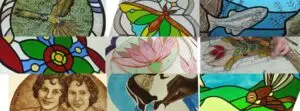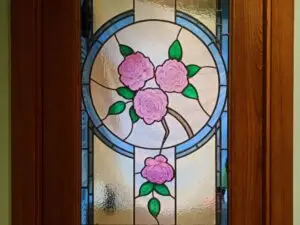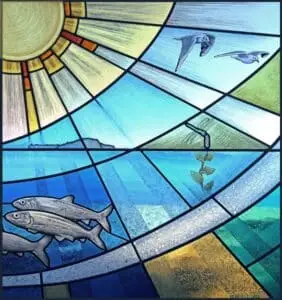Contemporary Stained Glass Window
Following a request by some of my Facebook followers, in this post I’m going to explain the process I used to create this contemporary stained glass window with spiral. I advocate the sharing of knowledge and techniques between stained glass artists which is one of the main reasons for writing this post.
The most important trick for this stained glass window was the type of glass I used. This contemporary stained glass panel is entire made of mouth blown glass from English Antique Glass. I made this window while I was still living in Birmingham and luckily I lived very closed to this spectacular company which makes flat, mouth-blown glass. The English Antique Glass produces glass using traditional methods, in my opinion despite the terms “traditional” and “antique” the handmade nature of this glass often lead to a glass which has a very modern and contemporary look. Often the glass is, rich in bubbles, textures, streaks and has wonderfully organic shades and gradations of colour.
My contemporary stained glass window contains a selection of one-off pieces of glass. The triangles were made from a glass with a rich gradation from orange to yellow and each piece was cut from a single glass sheet. I also used: streaky red-yellow glass, streaky gold, pink and amber glass and for the background I used a seedy clear glass.
To maintain the beauty and the transparency of this glass and to be in keeping with the contemporary design, I limited my use of glass paint and experimented with some different painting techniques. To lend movement to the spiral I followed the cut lines with a different set of overlapping painting effects which were then kiln fired separately. I followed the same process for the triangles leaving a clear area in the centre.
The unusual painting effect that you see on the spiral’s rays was obtain using Anaglypta textured wallpaper. I mixed the glass paint with higher quantities Arabic gum. The paint was applied directly to the wallpaper and then this was used to apply the paint to the glass. The effect it achieved was very pleasing.
To highlight the spiral I created a gradient using opaque white enamel which gradually fades out on the clear seedy glass and the round glass in the centre of the spiral was created plating two types of glass together, the first was a mouth blown glass with a strange cracked effect in it.
I hope that by sharing some of my knowledge and techniques it will encourage you to do the same. So, please, feel free to leave a comment or to share a tip or trick you’ve developed in your work.














